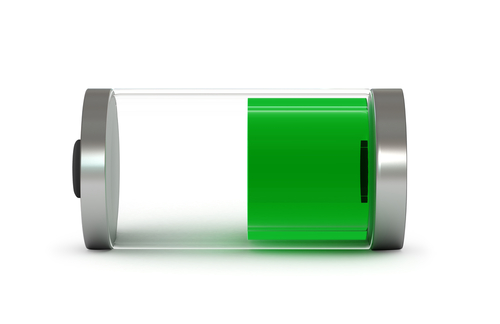 Lithium-ion batteries—which power everything from the largest datacenter UPS to the smallest mobile device—could be getting a major overhaul that not only increase their power, but also their potential lifespan. Engineers at Germany's Center for Solar Energy and Hydrogen Research at Baden-Wurrtemberg (ZSW) announced (PDF) that alterations in the manufacturing process could allow some lithium-ion batteries to be recharged as many as 10,000 times and remain useful for as long as 27 years. ZSW's announcement confirmed it had successfully manufactured batteries with improvements described in a research paper published in the Journal of Power Sources last year. In that paper, researchers described ways to increase the lifespan and power retention of an existing battery by altering the electrodes within it. By changing the thickness of the electrode, the degree of compaction, type of conductive agent and precise composition of the alloy, researchers could balance the flow of current through the battery more efficiently, allowing them to retain as much as 85 percent of their capacity even after 10,000 recharge cycles. ZSW successfully produced batteries in the 1860 format using the new techniques, but plans to develop larger batteries that could work in cars and other electric-powered devices. There is no estimate of when they may be available commercially. Though mention of lithium-ion batteries calls to mind the power inside laptops and smartphones, there are plenty in the datacenter as well—in power stabilizers, containerized battery systems, and other backup or power-management systems. Datacenter-hardware vendors have been building lithium-ion into UPSs and backup systems because they are lighter weight, require less maintenance, can be used in more scenarios and have three times the power density of lead-acid batteries. They can also be placed closer to the machines they back up, which makes the overall system more efficient. Extending the lifecycle of lithium-ion batteries by a couple of decades may seem like small potatoes compared to a design breakthrough at the Dept. of Energy's Oak Ridge National Laboratory, however. The Oak Ridge team announced last week they'd quadrupled the amount of energy in lithium-ion batteries by adding sulfur to the mix. Researchers have experimented with lithium-sulfur batteries for decades, but haven't been able to find a way to prevent the liquid electrolytes from breaking down the lithium and the battery prematurely. The Oak Ridge team replaced the liquid electrolytes with a solid material, while substituting the lithium oxide cathode at one end of the battery with a sulfur-containing material also created at the lab. The result was a solid battery able to maintain 1200 milliamp-hours per gram compared to normal batteries, which deliver between 130 mAh/g and 170mAh/g. That is an eightfold increase in output, the researchers wrote, which translates into a battery with four times the energy density of an ordinary lithium-ion battery. While the design is still in the research phase, the research team has already applied for a patent; they’re also developing methods of commercial manufacture. If better cathode balance (or adding sulfur) isn't enough to raise the power level or lifespan of the batteries that run most mobile technology and back up much of the stationary hardware in most data centers, trading the graphite on the negative electrodes for silicon could do it. Silicon has been used in lithium-ion batteries before, but breask down too easily as batteries charge or discharge. Researchers at Stanford University have figured out a way to pad silicon-based electrodes with a conductive polymer hydrogel–a spongy material close in density to soft contact lenses. The technique involves synthesizing the silicon in a nanostructure that provides greater resiliency, and coating the nanoparticles with hydrogel as they form. The result is a stable battery that kept its storage capacity through 5,000 cycles, which researchers attributed to the padded silicon nanostructure. The silicon-lithium-ion batteries will also remain in the lab until researchers find a practical way to manufacture them. The lead researcher is "optimistic" about commercial applications, but didn't project when they might be available. Image: vipman/Shutterstock.com
Lithium-ion batteries—which power everything from the largest datacenter UPS to the smallest mobile device—could be getting a major overhaul that not only increase their power, but also their potential lifespan. Engineers at Germany's Center for Solar Energy and Hydrogen Research at Baden-Wurrtemberg (ZSW) announced (PDF) that alterations in the manufacturing process could allow some lithium-ion batteries to be recharged as many as 10,000 times and remain useful for as long as 27 years. ZSW's announcement confirmed it had successfully manufactured batteries with improvements described in a research paper published in the Journal of Power Sources last year. In that paper, researchers described ways to increase the lifespan and power retention of an existing battery by altering the electrodes within it. By changing the thickness of the electrode, the degree of compaction, type of conductive agent and precise composition of the alloy, researchers could balance the flow of current through the battery more efficiently, allowing them to retain as much as 85 percent of their capacity even after 10,000 recharge cycles. ZSW successfully produced batteries in the 1860 format using the new techniques, but plans to develop larger batteries that could work in cars and other electric-powered devices. There is no estimate of when they may be available commercially. Though mention of lithium-ion batteries calls to mind the power inside laptops and smartphones, there are plenty in the datacenter as well—in power stabilizers, containerized battery systems, and other backup or power-management systems. Datacenter-hardware vendors have been building lithium-ion into UPSs and backup systems because they are lighter weight, require less maintenance, can be used in more scenarios and have three times the power density of lead-acid batteries. They can also be placed closer to the machines they back up, which makes the overall system more efficient. Extending the lifecycle of lithium-ion batteries by a couple of decades may seem like small potatoes compared to a design breakthrough at the Dept. of Energy's Oak Ridge National Laboratory, however. The Oak Ridge team announced last week they'd quadrupled the amount of energy in lithium-ion batteries by adding sulfur to the mix. Researchers have experimented with lithium-sulfur batteries for decades, but haven't been able to find a way to prevent the liquid electrolytes from breaking down the lithium and the battery prematurely. The Oak Ridge team replaced the liquid electrolytes with a solid material, while substituting the lithium oxide cathode at one end of the battery with a sulfur-containing material also created at the lab. The result was a solid battery able to maintain 1200 milliamp-hours per gram compared to normal batteries, which deliver between 130 mAh/g and 170mAh/g. That is an eightfold increase in output, the researchers wrote, which translates into a battery with four times the energy density of an ordinary lithium-ion battery. While the design is still in the research phase, the research team has already applied for a patent; they’re also developing methods of commercial manufacture. If better cathode balance (or adding sulfur) isn't enough to raise the power level or lifespan of the batteries that run most mobile technology and back up much of the stationary hardware in most data centers, trading the graphite on the negative electrodes for silicon could do it. Silicon has been used in lithium-ion batteries before, but breask down too easily as batteries charge or discharge. Researchers at Stanford University have figured out a way to pad silicon-based electrodes with a conductive polymer hydrogel–a spongy material close in density to soft contact lenses. The technique involves synthesizing the silicon in a nanostructure that provides greater resiliency, and coating the nanoparticles with hydrogel as they form. The result is a stable battery that kept its storage capacity through 5,000 cycles, which researchers attributed to the padded silicon nanostructure. The silicon-lithium-ion batteries will also remain in the lab until researchers find a practical way to manufacture them. The lead researcher is "optimistic" about commercial applications, but didn't project when they might be available. Image: vipman/Shutterstock.com Researchers Chase the Longer-Lasting Battery
 Lithium-ion batteries—which power everything from the largest datacenter UPS to the smallest mobile device—could be getting a major overhaul that not only increase their power, but also their potential lifespan. Engineers at Germany's Center for Solar Energy and Hydrogen Research at Baden-Wurrtemberg (ZSW) announced (PDF) that alterations in the manufacturing process could allow some lithium-ion batteries to be recharged as many as 10,000 times and remain useful for as long as 27 years. ZSW's announcement confirmed it had successfully manufactured batteries with improvements described in a research paper published in the Journal of Power Sources last year. In that paper, researchers described ways to increase the lifespan and power retention of an existing battery by altering the electrodes within it. By changing the thickness of the electrode, the degree of compaction, type of conductive agent and precise composition of the alloy, researchers could balance the flow of current through the battery more efficiently, allowing them to retain as much as 85 percent of their capacity even after 10,000 recharge cycles. ZSW successfully produced batteries in the 1860 format using the new techniques, but plans to develop larger batteries that could work in cars and other electric-powered devices. There is no estimate of when they may be available commercially. Though mention of lithium-ion batteries calls to mind the power inside laptops and smartphones, there are plenty in the datacenter as well—in power stabilizers, containerized battery systems, and other backup or power-management systems. Datacenter-hardware vendors have been building lithium-ion into UPSs and backup systems because they are lighter weight, require less maintenance, can be used in more scenarios and have three times the power density of lead-acid batteries. They can also be placed closer to the machines they back up, which makes the overall system more efficient. Extending the lifecycle of lithium-ion batteries by a couple of decades may seem like small potatoes compared to a design breakthrough at the Dept. of Energy's Oak Ridge National Laboratory, however. The Oak Ridge team announced last week they'd quadrupled the amount of energy in lithium-ion batteries by adding sulfur to the mix. Researchers have experimented with lithium-sulfur batteries for decades, but haven't been able to find a way to prevent the liquid electrolytes from breaking down the lithium and the battery prematurely. The Oak Ridge team replaced the liquid electrolytes with a solid material, while substituting the lithium oxide cathode at one end of the battery with a sulfur-containing material also created at the lab. The result was a solid battery able to maintain 1200 milliamp-hours per gram compared to normal batteries, which deliver between 130 mAh/g and 170mAh/g. That is an eightfold increase in output, the researchers wrote, which translates into a battery with four times the energy density of an ordinary lithium-ion battery. While the design is still in the research phase, the research team has already applied for a patent; they’re also developing methods of commercial manufacture. If better cathode balance (or adding sulfur) isn't enough to raise the power level or lifespan of the batteries that run most mobile technology and back up much of the stationary hardware in most data centers, trading the graphite on the negative electrodes for silicon could do it. Silicon has been used in lithium-ion batteries before, but breask down too easily as batteries charge or discharge. Researchers at Stanford University have figured out a way to pad silicon-based electrodes with a conductive polymer hydrogel–a spongy material close in density to soft contact lenses. The technique involves synthesizing the silicon in a nanostructure that provides greater resiliency, and coating the nanoparticles with hydrogel as they form. The result is a stable battery that kept its storage capacity through 5,000 cycles, which researchers attributed to the padded silicon nanostructure. The silicon-lithium-ion batteries will also remain in the lab until researchers find a practical way to manufacture them. The lead researcher is "optimistic" about commercial applications, but didn't project when they might be available. Image: vipman/Shutterstock.com
Lithium-ion batteries—which power everything from the largest datacenter UPS to the smallest mobile device—could be getting a major overhaul that not only increase their power, but also their potential lifespan. Engineers at Germany's Center for Solar Energy and Hydrogen Research at Baden-Wurrtemberg (ZSW) announced (PDF) that alterations in the manufacturing process could allow some lithium-ion batteries to be recharged as many as 10,000 times and remain useful for as long as 27 years. ZSW's announcement confirmed it had successfully manufactured batteries with improvements described in a research paper published in the Journal of Power Sources last year. In that paper, researchers described ways to increase the lifespan and power retention of an existing battery by altering the electrodes within it. By changing the thickness of the electrode, the degree of compaction, type of conductive agent and precise composition of the alloy, researchers could balance the flow of current through the battery more efficiently, allowing them to retain as much as 85 percent of their capacity even after 10,000 recharge cycles. ZSW successfully produced batteries in the 1860 format using the new techniques, but plans to develop larger batteries that could work in cars and other electric-powered devices. There is no estimate of when they may be available commercially. Though mention of lithium-ion batteries calls to mind the power inside laptops and smartphones, there are plenty in the datacenter as well—in power stabilizers, containerized battery systems, and other backup or power-management systems. Datacenter-hardware vendors have been building lithium-ion into UPSs and backup systems because they are lighter weight, require less maintenance, can be used in more scenarios and have three times the power density of lead-acid batteries. They can also be placed closer to the machines they back up, which makes the overall system more efficient. Extending the lifecycle of lithium-ion batteries by a couple of decades may seem like small potatoes compared to a design breakthrough at the Dept. of Energy's Oak Ridge National Laboratory, however. The Oak Ridge team announced last week they'd quadrupled the amount of energy in lithium-ion batteries by adding sulfur to the mix. Researchers have experimented with lithium-sulfur batteries for decades, but haven't been able to find a way to prevent the liquid electrolytes from breaking down the lithium and the battery prematurely. The Oak Ridge team replaced the liquid electrolytes with a solid material, while substituting the lithium oxide cathode at one end of the battery with a sulfur-containing material also created at the lab. The result was a solid battery able to maintain 1200 milliamp-hours per gram compared to normal batteries, which deliver between 130 mAh/g and 170mAh/g. That is an eightfold increase in output, the researchers wrote, which translates into a battery with four times the energy density of an ordinary lithium-ion battery. While the design is still in the research phase, the research team has already applied for a patent; they’re also developing methods of commercial manufacture. If better cathode balance (or adding sulfur) isn't enough to raise the power level or lifespan of the batteries that run most mobile technology and back up much of the stationary hardware in most data centers, trading the graphite on the negative electrodes for silicon could do it. Silicon has been used in lithium-ion batteries before, but breask down too easily as batteries charge or discharge. Researchers at Stanford University have figured out a way to pad silicon-based electrodes with a conductive polymer hydrogel–a spongy material close in density to soft contact lenses. The technique involves synthesizing the silicon in a nanostructure that provides greater resiliency, and coating the nanoparticles with hydrogel as they form. The result is a stable battery that kept its storage capacity through 5,000 cycles, which researchers attributed to the padded silicon nanostructure. The silicon-lithium-ion batteries will also remain in the lab until researchers find a practical way to manufacture them. The lead researcher is "optimistic" about commercial applications, but didn't project when they might be available. Image: vipman/Shutterstock.com 

